More than 30 years have passed since the birth of the DSP core, and it has been used in various products and applications. Nowadays, digital signal processing technology is familiar to us and has become indispensable to us.
This time, we will introduce the DSP, which has become a driving force in digital signal processing technology, along with the differences from microcomputers.
What is DSP in the first place?
DSP is an acronym for Digital Signal Processor (or Processing), and as the name suggests, it is a processor that specializes in digital signal processing.
All signals in the natural world (light, sound, vibration, etc.) are analog signals, and the DSP must input these analog signals as digitally sampled information. In addition, the DSP is designed to be able to process specific arithmetic processing, including the four arithmetic operations, at higher speeds.
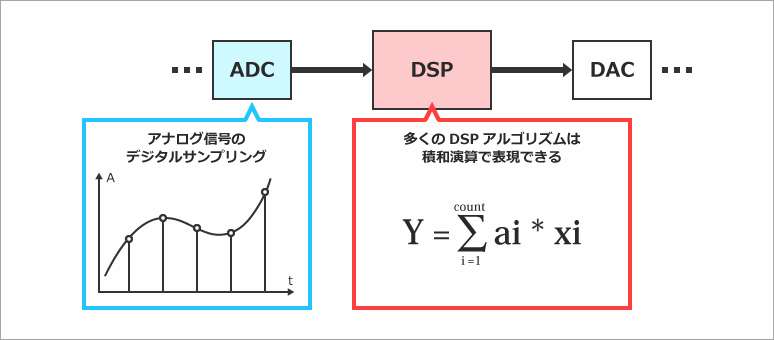
DSP core is good at multiply-accumulate operation
A major feature of DSP is that it has a multiplier as hardware. When executing multiplication with a general microcomputer, addition must be executed many times, but DSP can execute it in one cycle by using a multiplier.
Digital signal processing technology includes data compression/expansion, digital filtering, control, and recognition, and these algorithms frequently use multiply-accumulate operations. Multiply-and-accumulate operations are operations that combine multiplication and addition. It is no exaggeration to say that DSP was created to speed up this arithmetic processing.
As an example, the internal structure of the DSP core installed in the Texas Instruments (TI) C6000 DSP series consists of eight arithmetic units: a multiplier (M unit) and an adder (L unit). There are two units). Since each arithmetic unit operates independently, it is possible to execute multiply-accumulate operations twice in one cycle.
It also has a special SIMD (Single Instruction Multiple Data) instruction that executes multiple multiply-accumulate operations in one cycle, further improving the multiply-accumulate operation capability.
*The multiply-accumulate operation capability is sometimes called MAC (multiply-accumulate).
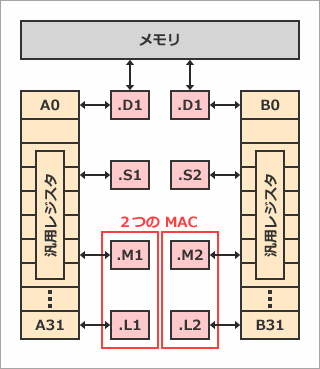
|
unit name |
function |
| .L unit | Arithmetic Logical Operation (ALU) |
| .M unit | Multiplier |
| .S unit | Standard Operation * Jump instruction, compare instruction, etc. |
| .D unit | Data addressing (Data) |
Data transfer method capable of high-speed transfer
The internal bus structure of many DSP devices uses the Harvard architecture. High-speed data throughput can be achieved by having a dedicated data bus compared to the Neumann architecture of the data bus in which the program memory and data memory are shared.
Also, in order to execute the sum-of-products operation in one cycle, two pieces of data must be input to the multiplier and the adder (the sum-of-products calculator). There are also products.
Compared to the Harvard architecture, the von Neumann architecture requires fewer data buses and can be implemented at a lower cost, so it is used in cost-conscious microcomputer products.
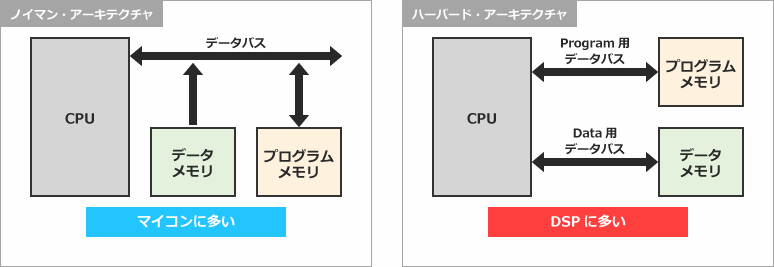
DSP products for various applications
DSPs are designed to be able to execute arithmetic operations such as sum-of-products operations at high speed, and inevitably demonstrate their capabilities in fields where arithmetic processing is frequently used. Today, it is used in various fields such as audio players, video players, telephone infrastructure, medical equipment, and security equipment.
TI has been developing DSP products for a long time, so there are products with various features. Here, we will introduce TI's DSP products.
Typical DSP series from TI
From products equipped with the C55x DSP core that achieves the industry's smallest class of low power consumption while maintaining high DSP computing power, to C66x DSP multi-core products focused on fields that require high-speed signal processing and high-speed communication, and We are developing a wide variety of products that support a wide range of embedded markets, including SoC products that also incorporate Arm® cores.
Based on performance and power consumption, it is positioned as shown in the figure below.
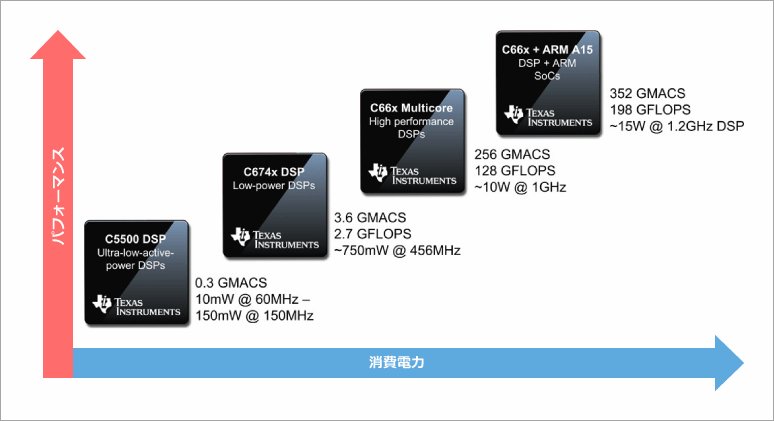
|
series name |
Features |
| C55x series | Efficient signal processing for ultra-low power, compact size embedded products |
| C674x series | Low-power real-time signal processing engine with fixed-point/floating-point DSP |
| C66x series | High-performance, scalable single-core and multi-core DSP |
| 66AK2x series | High performance and scalable DSP +Arm® multicore processor |
High performance and power efficiency
TI's C66x DSP core delivers 32 GMACS and 16 GFLOPS at 1 GHz, making it the industry's highest performing floating-point DSP core and offering an impressive performance/power consumption of 12 GFLOPS/W. And the C5500 DSP device with the C55x DSP core achieves a low power consumption of 0.20mW/MHz.
In addition, software development using C language is possible in the same way as program development with a microcomputer. By using libraries and codecs optimized for DSP cores, you can easily bring out DSP performance.
The chart below shows the performance comparison on the left and the full range of power efficient core counts on the right.
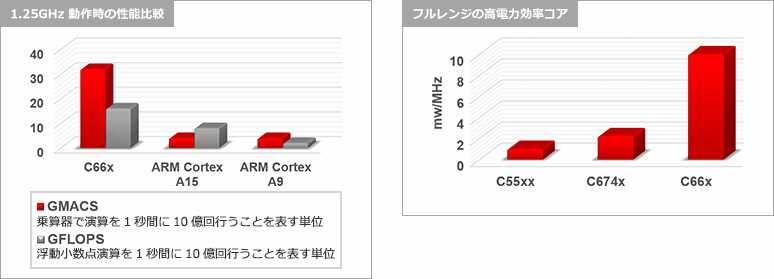
Proper use of DSP and microcomputer
A DSP capable of high-speed, high-capacity, complex arithmetic processing
DSPs specialize in performing large amounts of complex operations in a short amount of time.
For example, DSP has special instructions (SIMD instructions) for operations such as (16bit data x 16bit data) + (16bit data x 16bit data). Therefore, one instruction can be executed in one cycle, but if the same operation is executed by the microcomputer, multiple instructions must be processed.
In addition, such operations are often used in digital filter processing such as image processing algorithms for extracting only specific frequencies from audio data and for smoothing (smoothing) variations in image data.
Example of use
- Audio/video equipment (AV receivers, audio players, IP cameras, etc.)
- Machine vision (image inspection equipment, printers/scanners, etc.)

Easier and faster microcontrollers
On the other hand, microcomputers are more versatile and easier to use than DSPs. In addition, since there are various types of products, users can select the most suitable device according to their usage.
If you want to execute large-capacity and complicated arithmetic processing at high speed, you should choose a DSP, and if you want to realize various control more easily and quickly, you should choose a microcomputer.
Example of use
- Remote controls, household appliances (compressor control, display control, etc.)
- Sensor controller (pressure, temperature, gas, etc.)

Summary
In recent years, there are many microcomputers equipped with DSP instructions and microcomputers that adopt the Harvard architecture, and differences in function and structure are disappearing.
Microcontrollers have the advantage of being easy to use, as they have excellent versatility and have functions that can be used in a variety of applications. However, when processing complex calculations at high speed, it can be said that DSP still has the advantage.
By understanding these differences and using them properly according to the purpose, the optimum application can be realized. We have prepared application content for the DSP and microcomputer below, so please use it as a reference for component selection and development.
DSP (Digital Signal Processor) – Applications
Microcontroller (MCU) – Applications
Contact Us
If you would like more information about the DSPs introduced in this article or other TI products, please contact us here.
Related information
Click here for recommended articles/materials
Let's make a speech recognition demo that responds to phrases
We provide the whole basic configuration! 3 Recommended Speech Recognition Solutions
How to choose a microcomputer
LEA (Low Energy Accelerator) enables high-speed signal processing of microcomputers
6 recommended microcomputer boards! Introducing Arm®-equipped products for beginners
Click here to purchase products
C55x series
TMDX5535EZDSP C5535/C5545 eZdsp USB stick development kit
C674x series
TMS320C6748 DSP Development Kit (LCDK)
C66x series
TMS320C6678L Evaluation Module
66AK2x series
66AK2Gx (“K2G”) Evaluation Module
Click here for manufacturer site/other related links
digital signal processor
C66x/C674x Core Benchmark
C55X Core Benchmark
C6000 DSP training
TI 16-bit and 32-bit MCUs

